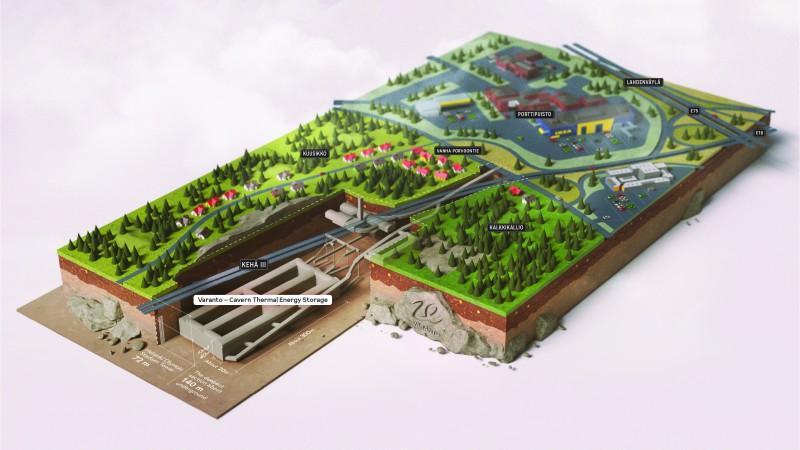Vantaa Energy, an urban energy company jointly owned by the cities of Vantaa and Helsinki, is planning the construction of the world’s largest seasonal heat storage system. At more than 1 million cubic meters in size, the underground heat storage system will have a total capacity that corresponds to the annual heating demand of a medium-sized Finnish city.
The 90 GWh seasonal thermal energy storage will be built in Vantaa, near Helsinki. A total of three caverns about 20 meters wide, 300 meters long, and 40 meters high will be excavated. The bottom of the caverns will be 100 meters below ground level.
The operating principle of the “Varanto” seasonal thermal energy storage is to store heat in underground caverns so that it can be used to heat buildings via the district heating network whenever needed.
The underground caverns, with a total volume of 1,100,000 cubic meters, including process facilities, will be filled with hot water. Pressure will be created within the space, allowing the water to reach temperatures of up to 140 C without the water boiling or evaporating.
The development stage of the Varanto project began in summer 2021. Back then, Vantaa Energy said it was working with Finnish construction company YIT and engineering consultant AFRY. Originally, the construction stage was supposed to begin in fall 2022 and the targeted time of completion was 2026.
Now, with all permits in place, the project is expected to break ground in summer this year and slated for completion in 2028. The project cost is estimated to be around €200 million ($217 million), and it has already been awarded a €19 million investment grant from Finland’s Ministry of Economic Affairs and Employment.
“The world is undergoing a huge energy transition. Wind and solar power have become vital technologies in the transition from fossil fuels to clean energy. The biggest challenge of the energy transition so far has been the inability to store these intermittent forms of energy for later use,” said Vantaa Energy CEO Jukka Toivonen. “Unfortunately, small-scale storage solutions, such as batteries or accumulators, are not sufficient; large, industrial-scale storage solutions are needed. Varanto is an excellent example of this, and we are happy to set an example for the rest of the world.”
Two 60 MW electric boilers will be built in conjunction with Varanto. These boilers will be used to produce heat from renewable electricity when electricity is abundant and cheap.
“Through the intelligent control of Varanto, electricity generation, waste heat and district heating, Vantaa will receive a hybrid system enabling us to take full advantage of the different energy sources,” said Toivonen. “Our heat-producing system will work like a hybrid car: alternating between electricity and other forms of production, depending on what is most advantageous and efficient at the time.”
Relative to population, Finland is the largest producer of district heat in the Nordic countries. In 2023, a total of 37.3 TWh of district heat was produced in Finland. Of this, 53% was produced from renewable heat sources and 14% from waste heat.
This content is protected by copyright and may not be reused. If you want to cooperate with us and would like to reuse some of our content, please contact: editors@pv-magazine.com.









By submitting this form you agree to pv magazine using your data for the purposes of publishing your comment.
Your personal data will only be disclosed or otherwise transmitted to third parties for the purposes of spam filtering or if this is necessary for technical maintenance of the website. Any other transfer to third parties will not take place unless this is justified on the basis of applicable data protection regulations or if pv magazine is legally obliged to do so.
You may revoke this consent at any time with effect for the future, in which case your personal data will be deleted immediately. Otherwise, your data will be deleted if pv magazine has processed your request or the purpose of data storage is fulfilled.
Further information on data privacy can be found in our Data Protection Policy.